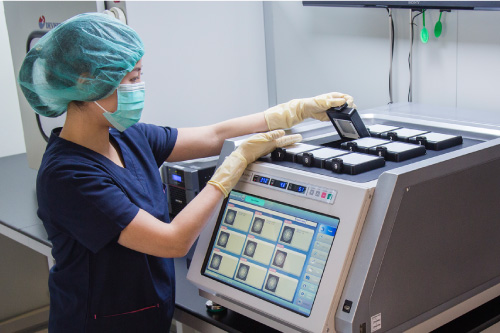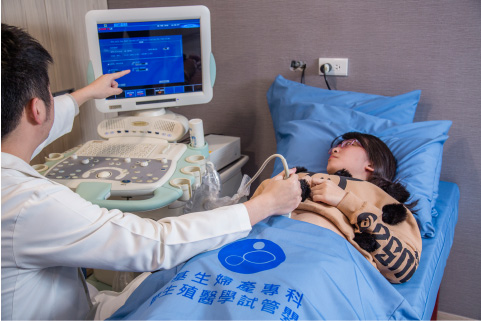First generation IVF
The first generation IVF assists fertility caused by female factors, especially the factors of fallopian tube. However male factor infertility cannot be solved by first generation IVF, and failure may occur.
The first generation IVF is also known as in vitro fertilization-embryo transfer(IVF-ET). In 1978, the first“test-tube baby” born through IVF technique in the United Kingdom. The sperm and the ovum(egg) are incubated in the same medium, and thennaturalfertilization occurs which laid the foundation of IVF.
The original technique is designed is for the infertile women who have fallopian tube obstruction. In the case that the man's sperm is normal, the ovum and the sperm are incubated in the same dish, so that the ovum goes on natural fertilization. During the culture process, the embryo undergoes a series of cell divisions, from 4-cell embryo on day 3 to the blastocyst on day 5-6, and then the embryo is transferred into the uterine continuing growth and development till delivery.
The indications of this technology include ovulation dysfunction, tubal obstruction or adhesion, endometriosis, and ovarian dysfunction.

Second generation IVF
The second generation IVF deals with male infertility factors, especially low or absent sperm count.
It is also called Intracytoplasmic Sperm Injection(ICSI) and a single sperm injection. First selecting the healthy sperms, a single sperm is injected into the cytoplasm of ovum. The ovum is in insemination and the development of the embryo is observed.After that, the embryo has been transferred into body to achieve the purpose of pregnancy.
In 1992, Dr. Gianpiero D. Palermo and Dr. Jia-En Liu successfully applied the ICSI for the first time in the human body. Theysolved the difficulties ofin vitro fertilization due to poor sperm motility, and the other male infertility factors. This technique is called the second generation IVF. It extends the indications and applications of IVF, and there were some guarantee of a certain fertilizations. For those who need this new technology, the increase of success rate is significant.
The main indications are
1、few or very low sperm count, too few motile sperms and morphologically normal sperms, such as round head sperms, which cannot penetrate the eggs
2、epididymal and testicular sperm aspiration
3、Autoimmune infertility
4、irreversible obstructive azoospermia
5、spermatogenic dysfunction
6、conventional in vitro fertilization failed
7、sperm acrosome abnormalities
8、unexplained infertility
Third generation IVF (PGS/PGD)
The third generation IVF is the preimplantation genetic diagnosis (PGS/PGD).
Based on the second generation IVF, the third generation IVF technique uses molecular diagnostic tests. By microscopic fine needle aspiration of the cells of embryos is performed in the blastocyst stage for molecular diagnosis, to prevent abortion caused by chromosomal abnormalities, or a baby with genetic defects. Healthy surplus embryos can be cryopreserved.

Third generation IVF under the foundation of biogenetics,
in order to choose healthy babies,
provides the opportunities to the parents who have genetic diseases.
Not only for women and male infertility, but also for women over the age of 35,
it excludes aneuploidy and overcome infertility or miscarriage caused by abnormal embryonic genes in older women.
In vitro fertility (IVF) process
The reproductive technology of GENE IVF isbeyond the international standards, and IVF technology has become the most popular method for difficult pregnancy.
-
Pre-treatment exam
Hysteroscopy and hysterosalpingogram (HSG) are used to view the inside of the uterus, anti-Muller's tube hormone (AMH).
-
Ovulation induction
Ovulation induction provides better maturation and quality of embryos. At present, the ovulation induction drugs includes short-acting and long-acting type. The short-acting type is GONAL-F and the long-acting type is ELONVA.
-
Return visit
Visit on day 6 to 7 of the menstruation after the ovulation induction. We monitor the follicular maturation by public ultrasound and blood test, and the timing of egg retrieval is decided.
-
HCG injection
According to the size of the follicle, HCG regimen is administrated.
-
Egg retrieval
Healthy sperm is selected to bind to the egg, and the embryo is incubateduntil the blastocyst stage in the laboratory.
-
Endometrium preparation
The endometrial thickness is preserved by the physician's medication in the second period, and the timing of implantation decided by following visits.
-
Implantation
Implantation of embryo is done on day 15-20 of the second menstruation. The surplus healthy embryos can continue to be frozen for future use.
Third generation IVF program
The reproductive technology of GENE IVF is beyond the international standards, and IVF has become the most popular method of infertility.
-
Pre-treatment examHysteroscopy and hysterosalpingogram (HSG) are used to view the inside of the uterus anti-Muller's tube hormone (AMH).
*Check the examination results from the attachment section before the operation -
First menstrual period
-
Ovulation stimulation/Return Visit (Day2-10)During the first menstrual period, patients need return visit on Day 2, and we apply ovulation induction from Day 2 to Day 10. We monitor the follicular maturation by public ultrasound and blood test, and the timing of egg retrieval is decided.
-
HCG injection on Day 10-12th of menstruation.According to the size of the follicle, and the doctor's assessment by blood test and ultrasound, HCG is injected to stimulates the release of the egg.
-
Egg retrieval procedure (within 36 hours of HCG injection)Choose healthy eggs combined with the fresh sperms
(husband comes together on this day)
└Embryo is intubated for 5-6 days untilblastocyst stage.
→NGS-PGS is done on Day 20-25
└You can go home according to your physical condition. -
Second menstruation
-
Preparation of endometriumThe endometrial thickness is preserved by the physician's medication in the second period, and the timing of implantation decided by following visits.
-
Implantation on Day 12-20Implantation of embryo is done on Day 15-20 in the second menstrual period. The surplus healthy embryos are frozen for future use.
Oversea third generation IVF program
-
Pre-treatment examHysteroscopy and hysterosalpingogram (HSG) are used to view the inside of the uterus anti-Muller's tube hormone (AMH).
*Check the examination results from the attachment section before the operation -
First menstrual period
-
Day 2-3 of the menstruationDuring the first menstrual period, patients need return visit on Day 2, and we apply ovulation induction from Day 2 to Day 10. We monitor the follicular maturation by public ultrasound and blood test, and the timing of egg retrieval is decided.
-
Visit local clinics in Meiland China on Day 2-8According to the doctor's assessment, blood test and ultrasound, and ovulation injection is arranged at the local clinics.Arrival in Taiwan on Day 8-9According to the doctor's assessment, blood test and ultrasound, the timing of egg retrieval is decided.HCG injection on Day 10-12th of menstruation.According to the size of the follicle, and the doctor's assessment by blood test and ultrasound, HCG is injected to stimulates the release of the egg.Egg retrieval procedure (within 36 hours of HCG injection)Choose healthy eggs combined with the fresh sperms(husband comes together on this day)
└Embryo is intubated for 5-6 days untilblastocyst stage.
→NGS-PGS is done on Day 20-25.
└You can go home according to your physical condition.Second menstruationPreparation of endometriumAccording to the size of the follicle and the doctor's assessment by blood test and ultrasound, HCG is injected to stimulate the release of the egg.Implantation on Day 12-20Implantation of embryo is done on Day 15-20 in the second menstrual period. The surplus healthy embryos are frozen for future use.
Examination reports:
Blood exam
| The karyotype analysis of husband and wife before the procedure facilitates the sharing of the information from the unified assessment. | |
| AMH | period 2-3 days |
| FSH | |
| LH | |
| E2 | |
| P4 | |
| Prolactin | |
| Anthrone | |
Ultrasonic report
| Left | period 2-3 days |
| right |
Semen test
| Sperm deformity | Procedure facilitates the sharing of the information from the unified assessment. |
| Fragment rate |
Immunity report
| ANA anti-nuclear antibody | Choosy eggs fertilize with the healthy sperm |
| TSH thyroid stimulating hormone | |
| Free T4 serum free thyroxine | |
| APTT activated partial thromboplastin time | |
| Protein S | |
| TNF-α tumor necrosis factor -α | |
| NK T cell | |
| (CD3+CD16+CD56),prefer to addCD3+、CD4+、CD8+ | |
| CA125 tumor marker | |
| D-dimer | |
| IGg | |
| IGm |
